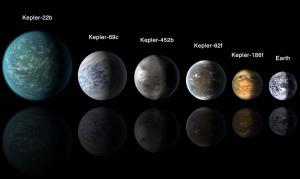Blog
Stuck in the Well
30 April 2018
 NASA/Ames/JPL-Caltech
NASA/Ames/JPL-CaltechIt started off as a joke. A bunch of terrestrial primates can make it into space, while a civilization of advanced aliens remains stuck on their world. But it turns out that the challenge of space flight is very real, and is worth considering in our search for alien life.
In our search for alien worlds, we have found countless exoplanets. Most are large planets similar to Jupiter or Neptune, and some are the size of Earth or a bit smaller, but some are in between these extremes. Known as super-Earths, they can have 10 times the mass of Earth and 3 times its diameter. There has been much discussion about what these planets are like. It’s quite possible that they are large enough to hold much of their early atmosphere, meaning they would have a thick hydrogen atmosphere similar to gas giants. But some astronomers have argued that super-Earths might be super-habitable. Their mass could allow it to hold plenty of water and a rich atmosphere, and their weight would drive the same kind of volcanic activity that may have allowed life on Earth to arise. If super-Earths are rocky worlds like our own, then they could be an excellent home for an alien civilization.
But as these aliens long to reach the stars, could they achieve that dream? It all comes down to some basic physics. To leave the surface of any planet, you need a certain amount of speed. Leave the surface of your world with too little speed, and you will fall back to the surface. But leave a planet’s surface with enough speed, and you can make it to orbit, or even leave the planet completely to float among the stars. The amount of speed you need is often represented as a change in velocity, or delta-v. For Earth, the escape velocity is 11 km/s. For Mars it is only 5 km/s, while massive Jupiter has an escape velocity of 60 km/s.
The delta-v needed to escape a planet depends upon its surface gravity, or how strongly a planet’s gravity pulls you to the surface. Surface gravity depends upon the total mass of a planet and its size. The more mass a planet has, the greater its surface gravity will tend to be, but the larger its size the smaller its surface gravity tends to be. For example, the super-Earth exoplanet Kepler-20b has about 9.7 times the mass of Earth, but is 1.87 times the size of Earth, so its surface gravity is only about 2.8 times that of Earth, and its escape velocity is about 2.3 times larger than Earth’s
That doesn’t seem like a huge deal. Just add a bit of extra fuel to your rockets, right? It turns out things aren’t so easy.1 When a rocket launches, it has to carry its own fuel, and that means it has to lift the weight of its fuel as well as the payload. The more fuel you add, the more fuel is wasted lifting the fuel. It becomes a game of diminishing returns. So more surface gravity means you need ever more fuel just to launch a rocket. For example, on Earth, the SpaceX Falcon Heavy can launch more than 50,000 kilograms of payload into low-Earth orbit. On Kepler-20b, a similar rocket could only launch 40 kilograms into orbit. That’s about as much as a few small cube satellites. Launching alien astronauts with their necessary life-support, or even space telescopes such has Hubble or TESS are out of the question. It would simply take too much fuel.
It is possible that nuclear power might make rockets feasible on a world like Kepler-20b. But that presents a whole other set of challenges. We haven’t mastered nuclear rockets, and if we do they will probably be used to travel the solar system, or even voyage to other stars. Nothing as trivial as launching rockets from Earth.
It’s possible that Earth is not just perfectly suited for life, it is also perfectly suited for a space-faring civilization. Large enough to have plenty of resources, but small enough to let us escape its gravitational bonds and explore the stars.
Hippke, Michael. “Spaceflight from Super-Earths is difficult.” arXiv preprint arXiv:1804.04727 (2018). ↩︎